Effects of Acoustic Perception on Outdoor Thermal Comfort in Campus Open Spaces in China’s Cold Region
Abstract
1. Introduction
2. Methods
2.1. Study Area
2.2. Experimental Design
2.2.1. Sound Selection
2.2.2. Meteorological Measures
2.3. Questionnaire Survey
2.4. Statistical Analysis
2.5. Respondents’ Attribute
3. Results
3.1. Meteorological Parameters
3.2. Thermal Perception
3.3. Acoustic Perception
3.3.1. Acoustic Sensation
3.3.2. Acoustic Comfort
3.3.3. Acoustic Evaluation
3.4. Effects of Acoustic Perception on Thermal Perception
3.4.1. Thermal Sensation at Different STPs
3.4.2. Thermal Comfort at Different STPs
3.4.3. NPET at Different STPs
3.4.4. NPET at Different ACV Levels
4. Discussion
4.1. Thermal Perception
4.2. Acoustic Perception
4.3. Strategies Based on Thermal–Acoustic Effects
4.4. Limitations
5. Conclusions
- There are significant differences among STPs in terms of acoustic perception and comfort and acoustic acceptability even though the SPLs are controlled. Broadcasting music, running water and birdsong, and wind (a gentle breeze) and insects make respondents feel more pleasant and acceptable, while crowds and machines are too loud and unpleasant.
- The respondents’ thermal comfort is related to STPs. Different STPs influence people’s acoustic comfort, thus influencing their thermal comfort. With natural sounds (running water and birdsong) and meaningful sound (broadcasting), people experience higher thermal comfort. In autumn, the thermal comfort order with different STPs is: wind (a gentle breeze) and insects > running water and birdsong > broadcasting music > machines > crowds. In winter, this order is: broadcasting music > wind (a gentle breeze) and insects > running water and birdsong > machines > crowds.
- The NPET is different for different STPs. In autumn, the NPET of machines, running water and birdsong, crowds, broadcasting music, and wind (a gentle breeze) and insects is 19.184 °C, 19.181 °C, 18.70 °C, 17.92 °C, and 17.56 °C, respectively. In winter, the NPET of machines, wind (a gentle breeze) and insects, crowds, broadcasting music, and running water and birdsong is 14.95 °C, 14.00 °C, 13.21 °C, 11.38 °C, and 11.26 °C, respectively. The NPET with machines is the highest in autumn and winter. People perceived high thermal sensation when they are acoustically comfortable, but low thermal sensation when in acoustic discomfort.
Author Contributions
Funding
Institutional Review Board Statement
Informed Consent Statement
Data Availability Statement
Conflicts of Interest
Nomenclature
| PG | Peony garden |
| CS | Campus square |
| WA | Wooded area |
| EG | Ecological garden |
| PS | Patio space |
| Brm | Broadcasting music |
| Rus | Running water and birdsong |
| Wis | Wind (a gentle breeze) and insects |
| Crn | Crowds |
| Macn | Machines |
| SVF | Sky view factor |
| ASV | Acoustic sensation vote |
| ACV | Acoustic comfort vote |
| TSV | Thermal sensation vote |
| TCV | Thermal comfort vote |
| PET | Physiological equivalent temperature |
| NPET | Neutral PET |
| STP | Sound type |
| Leq | Sound pressure level |
| Ta | Air temperature (°C) |
| RH | Relative humidity (%) |
| Va | Wind speed (m/s) |
| Tg | Globe temperature (°C) |
| Tmrt | Mean radiant temperature (°C) |
| G | Global radiation (W/m2) |
References
- Zijlema, W.L.; Triguero-Mas, M.; Smith, G.; Cirach, M.; Martinez, D.; Dadvand, P.; Gascon, M.; Jones, M.; Gidlow, C.; Hurst, G.; et al. The relationship between natural outdoor environments and cognitive functioning and its mediators. Environ. Res. 2017, 155, 268–275. [Google Scholar] [CrossRef] [PubMed]
- Gulwadi, G.B.; Mishchenko, E.D.; Hallowell, G.; Alves, S.; Kennedy, M. The restorative potential of a university campus: Objective greenness and student perceptions in Turkey and the United States. Landsc. Urban Plan. 2019, 187, 36–46. [Google Scholar] [CrossRef]
- Li, D.; Sullivan, W.C. Impact of views to school landscapes on recovery from stress and mental fatigue. Landsc. Urban Plan. 2016, 148, 149–158. [Google Scholar] [CrossRef]
- Lai, D.; Chen, B.; Liu, K. Quantification of the influence of thermal comfort and life patterns on outdoor space activities. Build. Simul. 2020, 13, 113–125. [Google Scholar] [CrossRef]
- Kang, J.; Yang, W. Soundscape in urban open public spaces. World Archit. 2002, 144, 76–79. [Google Scholar]
- Kang, J.; Aletta, F.; Gjestland, T.T.; Brown, L.A.; Botteldooren, D.; Schulte-Fortkamp, B.; Lercher, P.; van Kamp, I.; Genuit, K.; Fiebig, A.; et al. Ten questions on the soundscapes of the built environment. Build. Environ. 2016, 108, 284–294. [Google Scholar] [CrossRef]
- Shield, B.; Conetta, R.; Dockrell, J.; Connolly, D.; Cox, T.; Mydlarz, C. A survey of acoustic conditions and noise levels in secondary school classrooms in England. J. Acoust. Soc. Am. 2015, 137, 177–188. [Google Scholar] [CrossRef]
- Van Kamp, I.; Klaeboe, R.; Kruize, H.; Brown, A.L.; Lercher, P. Soundscapes, human restoration and quality of life, INTER-NOISE and NOISE-CON congress and conference proceedings. Inst. Noise Control Eng. 2016, 253, 1205–1215. [Google Scholar]
- Chen, L.; Ng, E. Outdoor thermal comfort and outdoor activities: A review of research in the past decade. Cities 2012, 29, 118–125. [Google Scholar] [CrossRef]
- Liu, W.; Zhang, Y.; Deng, Q. The effects of urban microclimate on outdoor thermal sensation and neutral temperature in hot-summer and cold-winter climate. Energy Build. 2016, 128, 190–197. [Google Scholar] [CrossRef]
- Lai, D.; Lian, Z.; Liu, W.; Guo, C.; Liu, W.; Liu, K.; Chen, Q. A comprehensive review of thermal comfort studies in urban open spaces. Sci. Total Environ. 2020, 742, 140092. [Google Scholar] [CrossRef] [PubMed]
- Chen, X.; Xue, P.; Liu, L.; Gao, L.; Liu, J. Outdoor thermal comfort and adaptation in severe cold area: A longitudinal survey in Harbin, China. Build. Environ. 2018, 143, 548–560. [Google Scholar] [CrossRef]
- Xu, M.; Hong, B.; Jiang, R.; An, L.; Zhang, T. Outdoor thermal comfort of shaded spaces in an urban park in the cold region of China. Build. Environ. 2019, 155, 408–420. [Google Scholar] [CrossRef]
- Yao, J.; Yang, F.; Zhuang, Z.; Shao, Y.; Yuan, P.F. The effect of personal and microclimatic variables on outdoor thermal comfort: A field study in a cold season in Lujiazui CBD, Shanghai. Sustain. Cities Soc. 2018, 39, 181–188. [Google Scholar] [CrossRef]
- Andrade, H.; Alcoforado, M.J.; Oliveira, S. Perception of temperature and wind by users of public outdoor spaces: Relationships with weather parameters and personal characteristics. Int. J. Biometeorol. 2011, 55, 665–680. [Google Scholar] [CrossRef] [PubMed]
- Nikolopoulou, M.; Lykoudis, S. Thermal comfort in outdoor urban spaces: Analysis across different European countries. Build. Environ. 2006, 41, 1455–1470. [Google Scholar] [CrossRef]
- Li, J.; Niu, J.; Mak, C.M.; Huang, T.; Xie, Y. Exploration of applicability of UTCI and thermally comfortable sun and wind conditions outdoors in a subtropical city of Hong Kong. Sustain. Cities Soc. 2020, 52, 101793. [Google Scholar] [CrossRef]
- Amindeldar, S.; Heidari, S.; Khalili, M. The effect of personal and microclimatic variables on outdoor thermal comfort: A field study in Tehran in cold season. Sustain. Cities Soc. 2017, 32, 153–159. [Google Scholar] [CrossRef]
- Huang, L.; Li, J.; Zhao, D.; Zhu, J. A fieldwork study on the diurnal changes of urban microclimate in four types of ground cover and urban heat island of Nanjing, China. Build. Environ. 2008, 43, 7–17. [Google Scholar] [CrossRef]
- Lee, Y.Y.; Md Din, M.F.; Iwao, K.; Lee, Y.H.; Anting, N. Impact of thermal behaviour of different environmental conditions on ambient environment and thermal discomfort in Malaysia. Indoor Built Environ. 2021, 30, 520–534. [Google Scholar] [CrossRef]
- Ghaffarianhoseini, A.; Berardi, U.; Ghaffarianhoseini, A.; Al-Obaidi, K. Analyzing the thermal comfort conditions of outdoor spaces in a university campus in Kuala Lumpur, Malaysia. Sci. Total Environ. 2019, 666, 1327–1345. [Google Scholar] [CrossRef] [PubMed]
- Lin, T.P.; Tsai, K.T.; Liao, C.C.; Huang, Y.C. Effects of thermal comfort and adaptation on park attendance regarding different shading levels and activity types. Build. Environ. 2013, 59, 599–611. [Google Scholar] [CrossRef]
- Rahman, M.A.; Hartmann, C.; Moser-Reischl, A.; von Strachwitz, M.F.; Paeth, H.; Pretzsch, H.; Pauleit, S.; Rötzer, T. Tree cooling effects and human thermal comfort under contrasting species and sites. Agric. For. Meteorol. 2020, 287, 107947. [Google Scholar] [CrossRef]
- Xu, X.; Sun, S.; Liu, W.; Garcia, E.H.; He, L.; Cai, Q.; Xu, S.; Wang, J.; Zhu, J. The cooling and energy saving effect of landscape design parameters of urban park in summer: A case of Beijing, China. Energy Build. 2017, 149, 91–100. [Google Scholar] [CrossRef]
- Mahmoud, A.H.A. Analysis of the microclimatic and human comfort conditions in an urban park in hot and arid regions. Build. Environ. 2011, 46, 2641–2656. [Google Scholar] [CrossRef]
- Huang, Z.; Gou, Z.; Cheng, B. An investigation of outdoor thermal environments with different ground surfaces in the hot summer-cold winter climate region. J. Build. Eng. 2020, 27, 100994. [Google Scholar] [CrossRef]
- Lai, D.; Zhou, X.; Chen, Q. Measurements and predictions of the skin temperature of human subjects on outdoor environment. Energy Build. 2017, 151, 476–486. [Google Scholar] [CrossRef]
- Niu, J.; Hong, B.; Geng, Y.; Mi, J.; He, J. Summertime physiological and thermal responses among activity levels in campus outdoor spaces in a humid subtropical city. Sci. Total Environ. 2020, 728, 138757. [Google Scholar] [CrossRef]
- Wang, H.; Hu, S. Experimental study on thermal sensation of people in moderate activities. Build. Environ. 2016, 100, 127–134. [Google Scholar] [CrossRef]
- Su, M.; Hong, B.; Su, X.; Liu, A.; Chang, J. How the nozzle density and height of mist spraying affect pedestrian outdoor thermal comfort: A field study. Build. Environ. 2022, 215, 108968. [Google Scholar] [CrossRef]
- Chen, X.; Xue, P.; Gao, L.; Du, J.; Liu, J. Physiological and thermal response to real-life transient conditions during winter in severe cold area. Build. Environ. 2019, 157, 284–296. [Google Scholar] [CrossRef]
- Zhang, Y.; Zhou, X.; Zheng, Z.; Oladokun, M.O.; Fang, Z. Experimental investigation into the effects of different metabolic rates of body movement on thermal comfort. Build. Environ. 2020, 168, 106489. [Google Scholar] [CrossRef]
- Wu, Y.; Liu, H.; Li, B.; Kosonen, R.; Wei, S.; Jokisalo, J.; Cheng, Y. Individual thermal comfort prediction using classification tree model based on physiological parameters and thermal history in winter. Build. Simul. 2021, 14, 1651–1665. [Google Scholar] [CrossRef]
- Smith, P.; Henríquez, C. Perception of thermal comfort in outdoor public spaces in the medium-sized city of Chillán, Chile, during a warm summer. Urban Clim. 2019, 30, 100525. [Google Scholar] [CrossRef]
- He, X.; An, L.; Hong, B.; Huang, B.; Cui, X. Cross-cultural differences in thermal comfort in campus open spaces: A longitudinal field survey in China’s cold region. Build. Environ. 2020, 172, 106739. [Google Scholar] [CrossRef]
- Aljawabra, F.; Nikolopoulou, M. Thermal comfort in urban spaces: A cross-cultural study in the hot arid climate. Int. J. Biometeorol. 2018, 62, 1901–1909. [Google Scholar] [CrossRef] [PubMed]
- Eliasson, I.; Knez, I.; Westerberg, U.; Thorsson, S.; Lindberg, F. Climate and behaviour in a Nordic city. Landsc. Urban Plan. 2007, 82, 72–84. [Google Scholar] [CrossRef]
- Tung, C.H.; Chen, C.P.; Tsai, K.T.; Kantor, N.; Hwang, R.L.; Matzarakis, A.; Lin, T.P. Outdoor thermal comfort characteristics in the hot and humid region from a gender perspective. Int. J. Biometeorol. 2014, 58, 1927–1939. [Google Scholar] [CrossRef] [PubMed]
- Shooshtarian, S.; Ridley, I. The effect of individual and social environments on the users thermal perceptions of educational urban precincts. Sustain. Cities Soc. 2016, 26, 119–133. [Google Scholar] [CrossRef]
- International Standard 12913-1; Acoustics-Soundscape-Part 1: Definition and Conceptual Framework. ISO: Geneva, Switzerland, 2014.
- Wang, Y.; Yin, C.; Ji, X.; Wang, Y. Experimental study on soundscape and audio-visual perception of urban historic district. Appl. Acoust. 2020, 39, 104–111. [Google Scholar]
- Lian, Y.; Ou, D.; Pan, S.; Yang, L. An evaluation study on soundscape of different landscape space types. Build. Sci. 2020, 36, 57–63. (In Chinese) [Google Scholar]
- Yang, L.; Zhang, J.; Xu, Y.; Chen, X. Soundscape subjective evaluation based on tourists’ preference: A case study of Dayan ancient town. Appl. Acoust. 2020, 39, 625–631. [Google Scholar]
- Meng, Q.; Kang, J.; Jin, H. Field study on the influence of users’ social qualities on the evaluation of subjective loudness and acoustic comfort in underground shopping streets. Appl. Acoust. 2010, 29, 371–381. [Google Scholar]
- Yu, L.; Kang, J. Modeling subjective evaluation of soundscape quality in urban open spaces: An artificial neural network approach. J. Acoust. Soc. Am. 2009, 126, 1163–1174. [Google Scholar] [CrossRef] [PubMed]
- Tsai, K.T.; Lin, Y.H. Identification of urban park activity intensity at different thermal environments and visible sky by using sound levels. Int. J. Biometeorol. 2018, 62, 1987–1994. [Google Scholar] [CrossRef] [PubMed]
- Hirashima, S.Q.S.; Assis, E.S. Sound perception and acoustic comfort in urban spaces in the city of Belo Horizonte, MG. Ambiente Constr. 2017, 17, 7–22. [Google Scholar] [CrossRef][Green Version]
- Larriva, M.T.B.; Higueras, E. Health risk for older adults in Madrid, by outdoor thermal and acoustic comfort. Urban Clim. 2020, 34, 100724. [Google Scholar] [CrossRef]
- Lau, K.K.; Choi, C.Y. The influence of perceived aesthetic and acoustic quality onoutdoor thermal comfort in urban environment. Build. Environ. 2021, 206, 108333. [Google Scholar] [CrossRef]
- Pellerin, N.; Candas, V. Combined effects of temperature and noise on human discomfort. Physiol. Behav. 2003, 78, 99–106. [Google Scholar] [CrossRef]
- Pellerin, N.; Candas, V. Effects of steady-state noise and temperature conditions on environmental perception and acceptability. Indoor Air 2004, 14, 129–136. [Google Scholar] [CrossRef]
- Yang, W.; Moon, H.J.; Kim, M.J. Combined effects of short-term noise exposure and hygrothermal conditions on indoor environmental perceptions. Indoor Built Environ. 2018, 27, 1119–1133. [Google Scholar] [CrossRef]
- Parker, C.; Barnes, S.; Mckee, K.; Morgan, K.; Torringtong, J.; Tregenza, P. Quality of life and building design in residential and nursing homes for older people. Ageing Soc. 2004, 24, 941–962. [Google Scholar] [CrossRef]
- Tartarini, F.; Cooper, P.; Fleming, R. Thermal environment and thermal sensations of occupants of nursing homes: A field study. Procedia Eng. 2017, 180, 373–382. [Google Scholar] [CrossRef]
- Mendes, A.; Papoila, A.L.; Carreiro-Martins, P.; Aguiar, L.; Bonassi, S.; Caires, I.; Caires, L.; Palmeiro, T.; Ribeiro, Á.S.; Neves, P.; et al. The Influence of Thermal Comfort on the Quality of Life of Nursing Home Residents. J. Toxicol. Environ. Health 2017, 80, 729–739. [Google Scholar] [CrossRef] [PubMed]
- Wiratha, M.S.; Tsaih, L. Acoustic comfort in long-term care facilities based on listening impressions from normal hearing individuals. Proc. Meet. Acoust. 170ASA 2015, 25, 015003. [Google Scholar]
- Mueller-Schotte, S.; Huisman, E.; Huisman, C.; Kort, H. The influence of the indoor environment on people displaying challenging behaviour: A scoping review. Technol. Disabil. 2022, 34, 133–140. [Google Scholar] [CrossRef]
- Devos, P.; Aletta, F.; Vander Mynsbrugge, T.; Thomas, P.; Filipan, K.; Petrovic, M.; De Vriendt, P.; Van de Velde, D.; Botteldooren, D. Soundscape design for management of behavioral disorders: A pilot study among nursing home residents with dementia. INTER-NOISE and NOISE-CON congress and conference proceedings. Inst. Noise Control. Eng. 2018, 258, 2104–2111. [Google Scholar]
- Putkinen, V.; Makkonen, T.; Eerola, T. Music-induced positive mood broadens the scope of auditory attention. Soc. Cogn. Affect. Neur. 2017, 12, 1159–1168. [Google Scholar] [CrossRef]
- McGill, P.; Teer, K.; Rye, L.; Hughes, D. Staff reports of setting events associated with challenging behavior. Behav. Modif. 2005, 29, 599–615. [Google Scholar] [CrossRef]
- Nitidara, N.P.A.; Sarwono, J.; Suprijanto, S.; Nugroho Soelami, F.X. The multisensory interaction between auditory, visual, and thermal to the overall comfort in public open space: A study in a tropical climate. Sustain. Cities Soc. 2022, 78, 103622. [Google Scholar] [CrossRef]
- Peel, M.C.; Finlayson, B.L.; McMahon, T.A. Updated world map of the Köppen-Geiger climate classification. Hydrol. Earth Syst. Sc. 2007, 11, 259–263. [Google Scholar] [CrossRef]
- China Meteorological Administration (CMA). Available online: http://data.cma.cn/ (accessed on 17 July 2022).
- Sun, C.Y. A street thermal environment study in summer by the mobile transect technique. Theor. Appl. Climatol. 2011, 106, 433–442. [Google Scholar] [CrossRef]
- Ballas, J.A. Common factors in the identification of an assortment of brief everyday sounds. J. Exp. Psychol. Hum. 1993, 19, 250–267. [Google Scholar] [CrossRef]
- Dubois, D. Categories as acts of meaning: The case of categories in olfaction and audition. Cogn. Sci. 2000, 1, 35–68. [Google Scholar]
- Gaver, W.W. What in the world do we hear?: An ecological approach to auditory event perception. Ecol. Psychol. 1993, 5, 1–29. [Google Scholar] [CrossRef]
- Yang, W.; Kang, J. Acoustic comfort evaluation in urban open public spaces. Appl. Acoust. 2005, 66, 211–229. [Google Scholar] [CrossRef]
- American Standard. Acoustical Terminology. Academic Medicine; American National Standards Institute: New York, NY, USA, 1994; p. 26. [Google Scholar]
- Gravetter, F.J.; Wallnau, L.B. Statistics for Behavioral Sciences, 8th ed.; Wadsworth: Belmont, CA, USA, 2009. [Google Scholar]
- Brown, A.L.; Gjestland, T.; Dubois, D. Acoustic environments and soundscapes. In Soundscape and the Built Environment; Kang, J., Schulte-Fortkamp, B., Eds.; CRC Press: Boca Raton, FL, USA, 2016; pp. 1–16. [Google Scholar]
- Axelsson, Ö.; Nilsson, M.E.; Berglund, B. The Swedish soundscape-quality protocol. J. Acoust. Soc. Am. 2012, 131, 3476. [Google Scholar] [CrossRef]
- Axelsson, Ö.; Nilsson, M.E.; Berglund, B. A Swedish instrument for measuring soundscape quality. Proc. Inst. Acoust. 2009, 31, 199–206. [Google Scholar]
- Liu, J.; Kang, J.; Luo, T.; Behm, H.; Coppack, T. Spatiotemporal variability of soundscapes in a multiple functional urban area. Landsc. Urban Plan. 2013, 115, 1–9. [Google Scholar] [CrossRef]
- Jeon, J.Y.; Jo, H.I. Effects of audio-visual interactions on soundscape and landscape perception and their influence on satisfaction with the urban environment. Build. Environ. 2020, 169, 106544. [Google Scholar] [CrossRef]
- Jeon, J.Y.; Hong, J.Y. Classification of urban park soundscapes through perceptions of the acoustical environments. Landsc. Urban Plan. 2015, 141, 100–111. [Google Scholar] [CrossRef]
- Axelsson, Ö.; Nilsson, M.E.; Berglund, B. A principal components model of soundscape perception. J. Acoust. Soc. Am. 2010, 128, 2836–2846. [Google Scholar] [CrossRef] [PubMed]
- Jin, Y.; Jin, H.; Kang, J. Combined effects of the thermal-acoustic environment on subjective evaluations in urban squares. Build. Environ. 2020, 168, 106517. [Google Scholar] [CrossRef]
- GB3096–2008; Environmental Quality Standard for Noise. Ministry of Ecology and Environment of the People’s Republic of China: Beijing, China, 2008.
- ASHRAE Standard 55; Thermal Environmental Conditions for Human Occupancy. American Society of Heating. Refrigerating and Air-Conditioning Engineers: Atlanta, GA, USA, 2013.
- International Standard 7726; Thermal Environment—Instruments and Method for Measuring Physical Quantities. ISO: Geneva, Switzerland, 1998.
- Hodder, S.G.; Parsons, K. The effects of solar radiation on thermal comfort. Int. J. Biometeorol. 2007, 51, 233–250. [Google Scholar] [CrossRef]
- Axelsson, Ö.; Nilsson, M.; Berglund, B. Validation of the Swedish soundscape quality protocol. J. Acoust. Soc. Am. 2012, 131, 3474. [Google Scholar] [CrossRef]
- International Standard 10551; Ergonomics of the Physical environment—Subjective Judgement Scales for Assessing Physical Environment. ISO: Geneva, Switzerland, 2019.
- Honjo, T. Thermal comfort in outdoor environment. Glob. Environ. Res. 2009, 13, 43–47. [Google Scholar]
- International Standard 7730; Ergonomics of the Thermal Environment-Analytical Determination and Interpretation of Thermal Comfort Using Calculation of the PMV and PPD Indices and Local Thermal Comfort Criteria. ISO: Geneva, Switzerland, 2005.
- Matzarakis, A.; Rutz, F.; Mayer, H. Modelling radiation fluxes in simple and complex environments-application of the RayMan model. Int. J. Biometeorol. 2007, 51, 323–334. [Google Scholar] [CrossRef]
- Nikolopoulou, M.; Steemers, K. Thermal comfort and psychological adaptation as a guide for designing urban spaces. Energy Build. 2003, 35, 95–101. [Google Scholar] [CrossRef]
- Guan, H.; Hu, S.; Lu, M.; He, M.; Mao, Z.; Liu, G. People’s subjective and physiological responses to the combined thermal-acoustic environments. Build. Environ. 2020, 172, 106709. [Google Scholar] [CrossRef]
- Nagano, K.; Horikoshi, T. New index of combined effect of temperature and noise on human comfort: Summer experiments on hot ambient temperature and traffic noise. Arch. Complex Environ. Stud. 2001, 13, 9. [Google Scholar]
- Yin, Y.; Zhang, D.; Zhen, M.; Jing, W.; Luo, W.; Feng, W. Combined effects of the thermal-acoustic environment on subjective evaluations in outdoor public spaces. Sustain. Cities Soc. 2022, 77, 103522. [Google Scholar] [CrossRef]
- Yang, W.; Moon, H.J. Cross-modal effects of noise and thermal conditions on indoor environmental perception and speech recognition. Appl. Acoust. 2018, 141, 1–8. [Google Scholar] [CrossRef]
- Yang, W.; Moon, H.J. Combined effects of acoustic, thermal, and illumination conditions on the comfort of discrete senses and overall indoor environment. Build. Environ. 2019, 148, 623–633. [Google Scholar] [CrossRef]
- Ma, K.W.; Mak, C.M.; Wong, H.M. Effects of environmental sound quality on soundscape preference in a public urban space. Appl. Acoust. 2021, 171, 107570. [Google Scholar] [CrossRef]
- Bahali, S.; Tamer-Bayazit, N. Soundscape research on the Gezi Park-Tunel Square route. Appl. Acoust. 2017, 116, 260–270. [Google Scholar] [CrossRef]


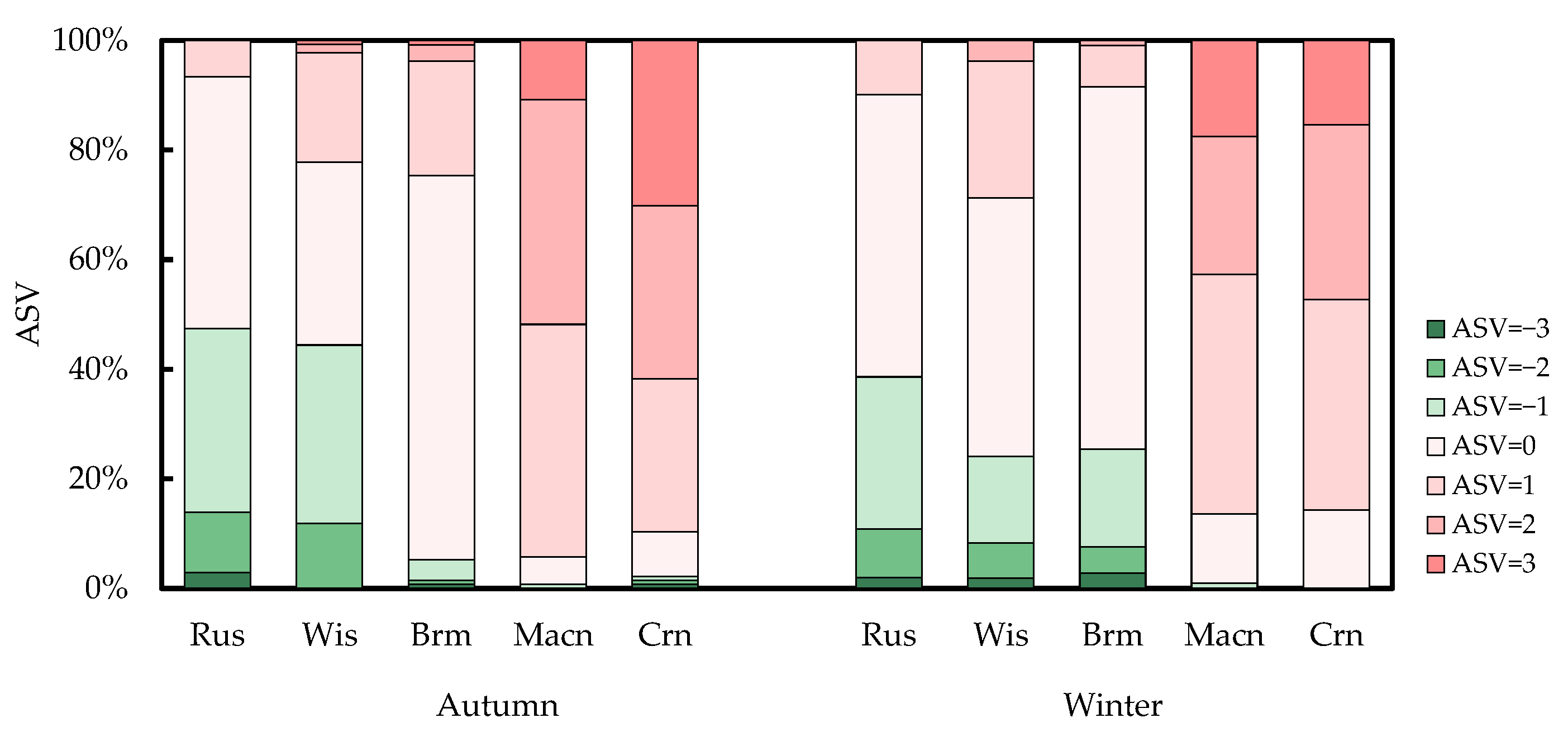
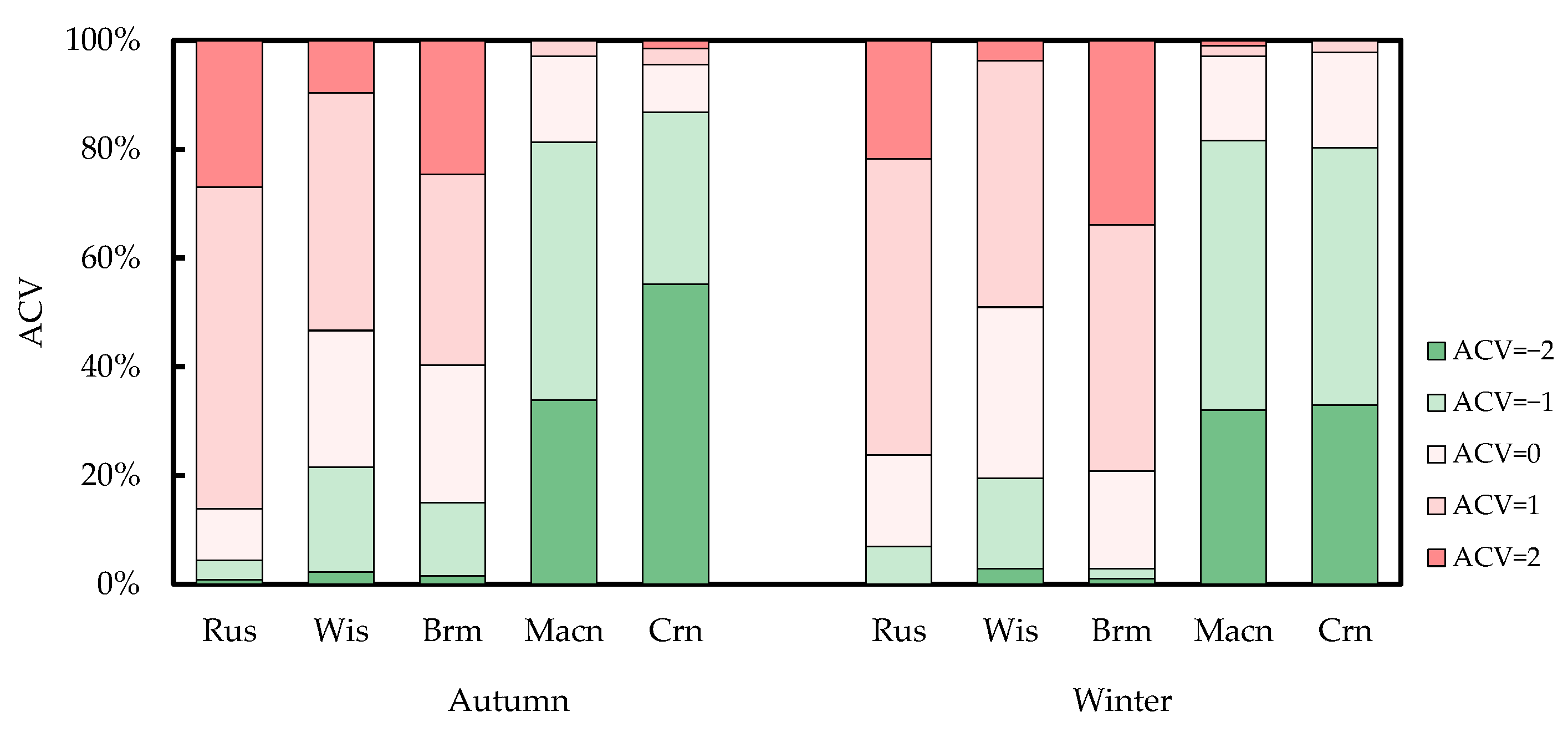
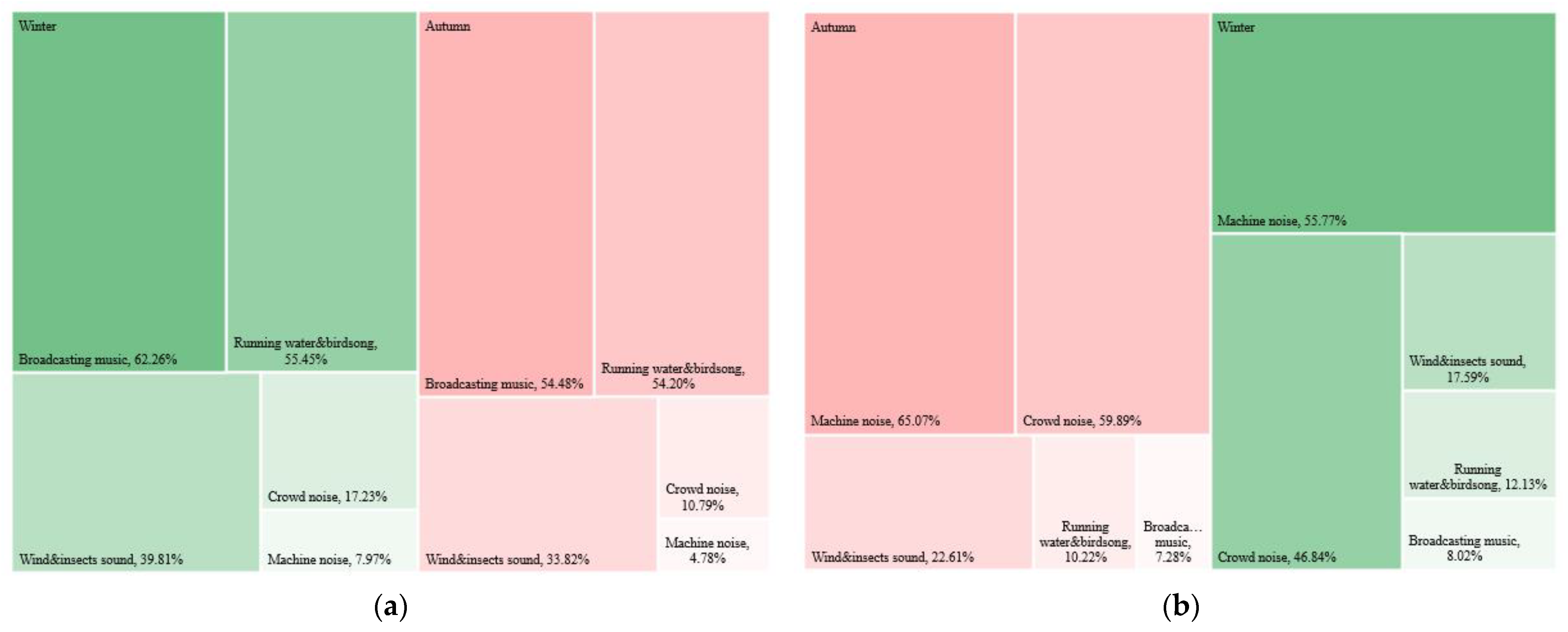
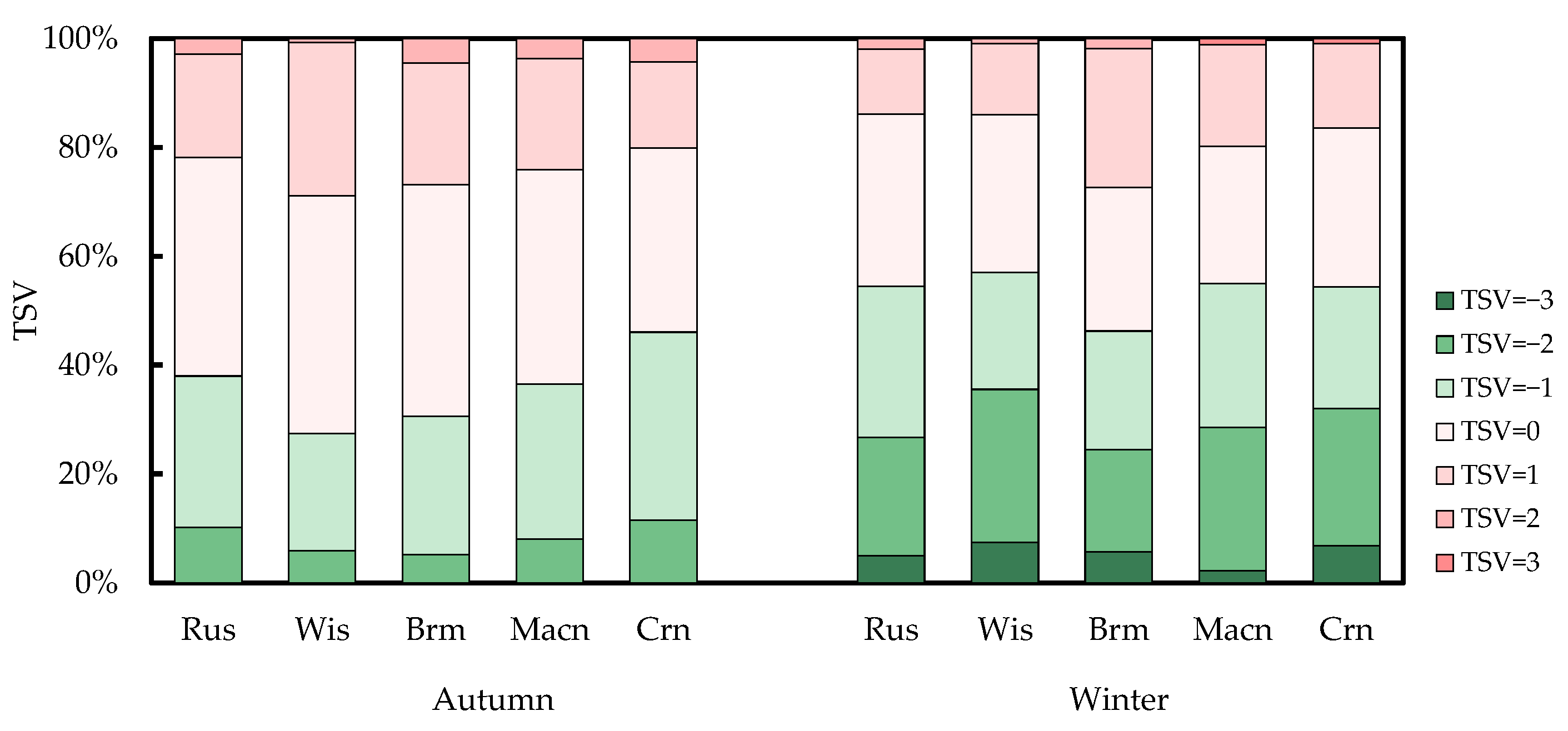
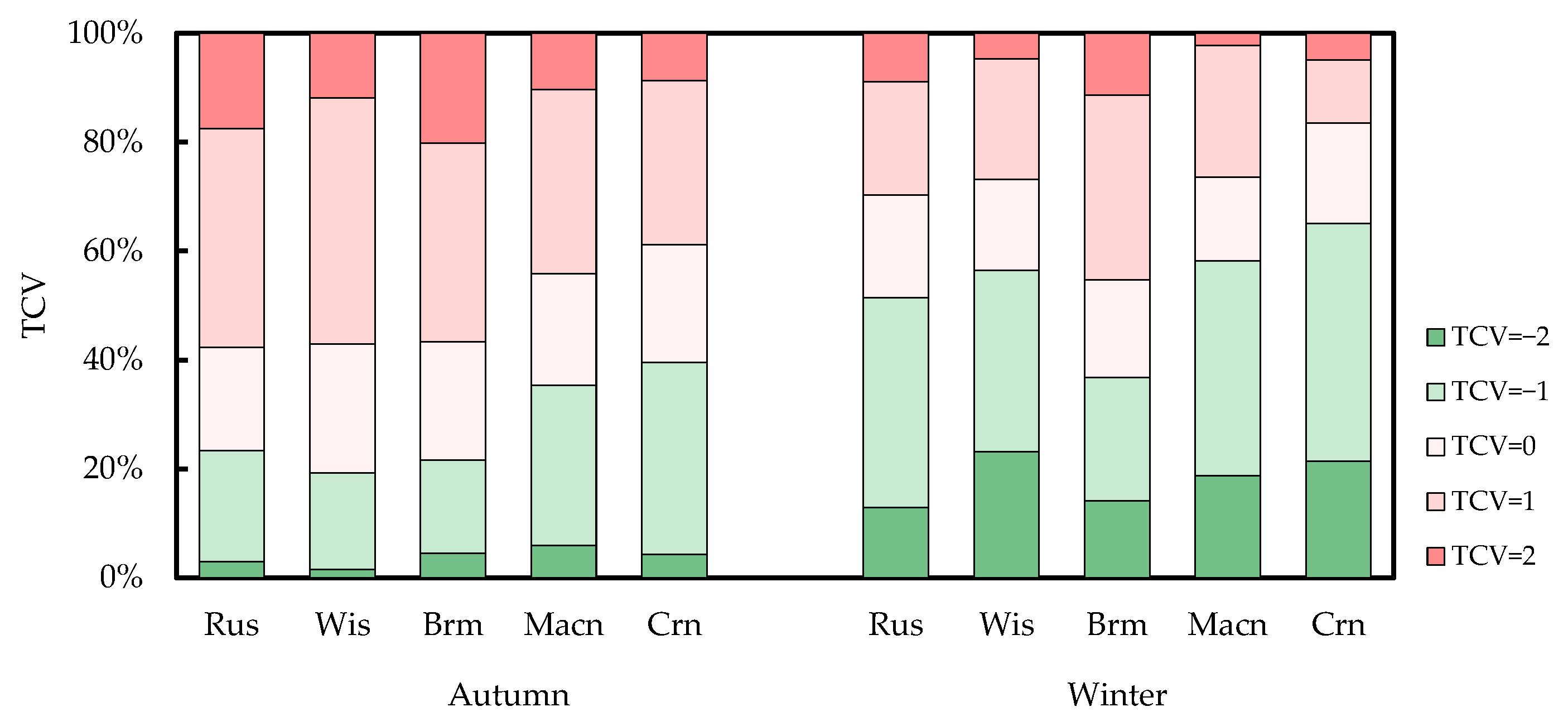

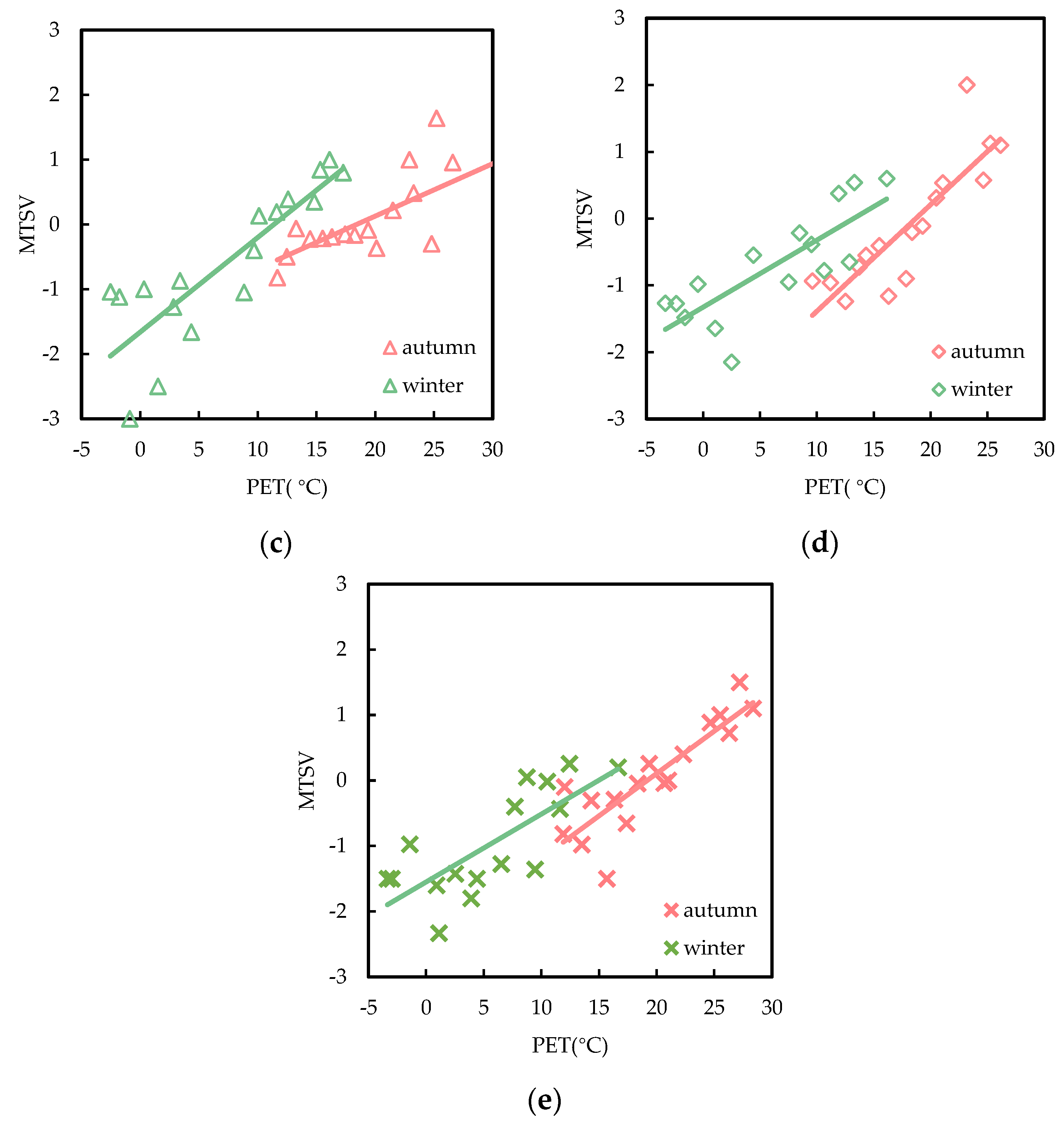
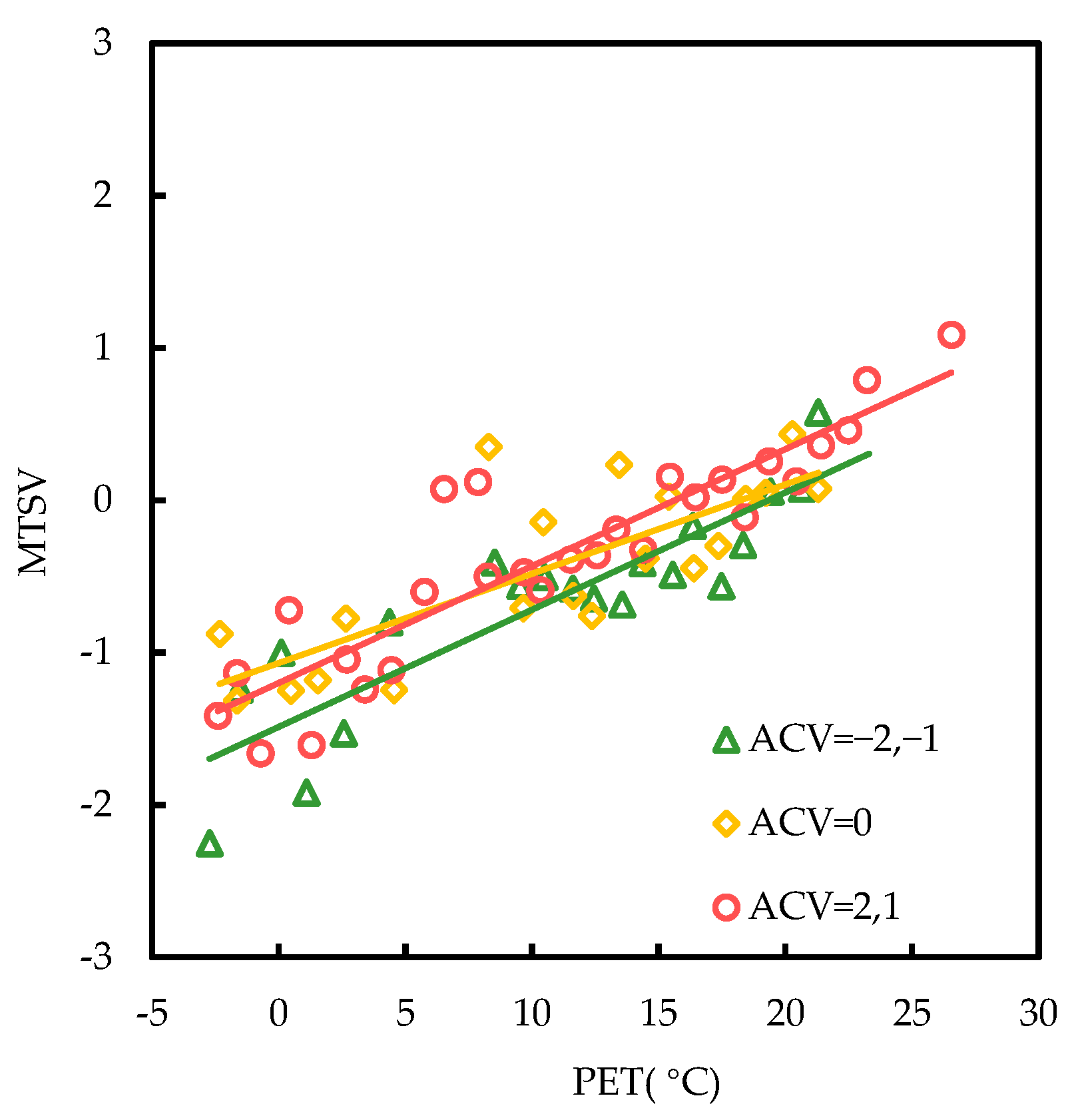
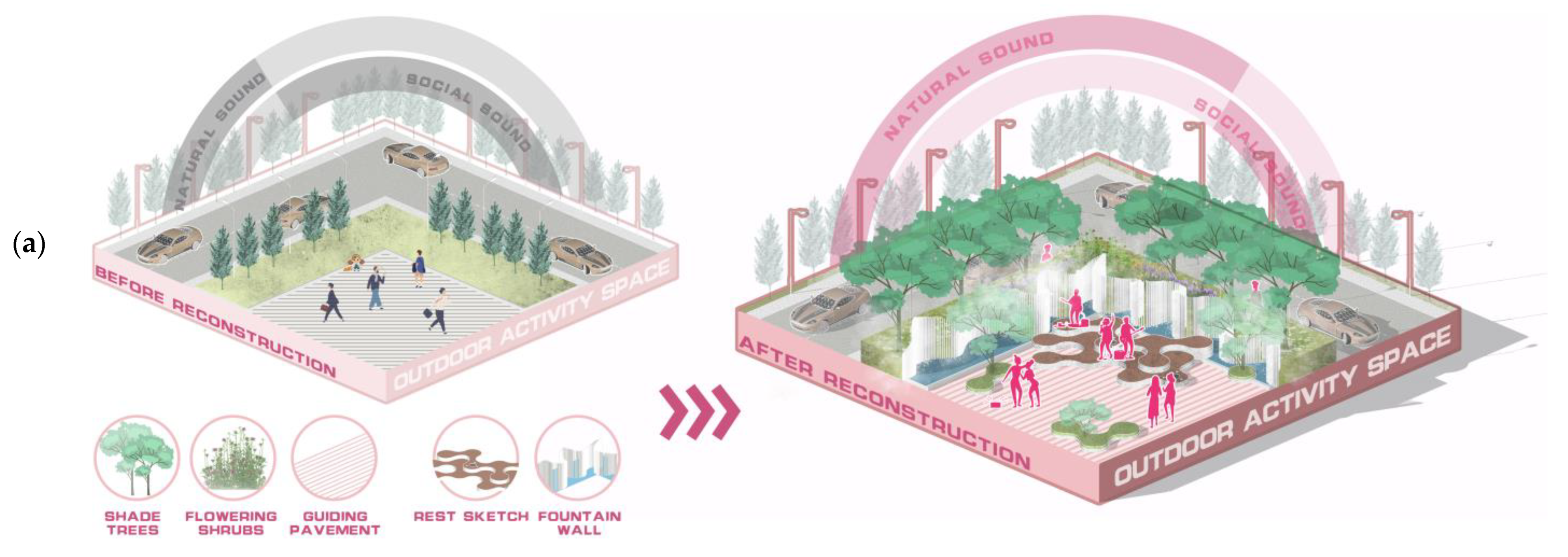


| Space | Aerial Photograph | Autumn | Winter |
|---|---|---|---|
| Peony garden (PG) | 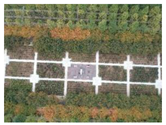 | 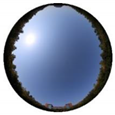 | 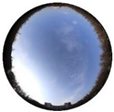 |
| SVF = 0.7385 | SVF = 0.7500 | ||
| Wooded area (WA) | 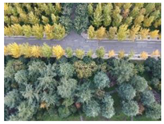 |  |  |
| SVF = 0.1356 | SVF = 0.2480 | ||
| Campus square (CS) | 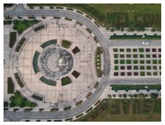 |  |  |
| SVF = 0.8602 | SVF = 0.8674 | ||
| Ecological garden (EG) | 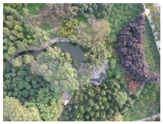 |  | 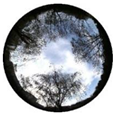 |
| SVF = 0.3004 | SVF = 0.5163 | ||
| Patio space (PS) | 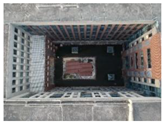 |  |  |
| SVF = 0.1515 | SVF = 0.1517 |
| Instrument | Parameters | Range | Precision |
|---|---|---|---|
| HOBO onset U23-001 | Air temperature | −40–70 °C | ±0.21 °C |
| Relative humidity | 0–100% | ±2.5% | |
| Kestrel 5500 | Wind speed | 0–40 m/s | 0.1 m/s |
| Delta OHM HD2107.2 | Globe temperature | −30–120 °C | ±0.25 °C |
| JTR05 | Global radiation | 0–2000 W/m2 | ≤±2% |
| AWA5688 | A weighted sound pressure level | 28 dBA–133 dBA |
| Season | Age | Gender | Number | Height (cm) | Weight (kg) |
|---|---|---|---|---|---|
| autumn | 18–26 | male | 35 | 177.1 ± 6.32 | 67.4 ± 10.42 |
| 17–25 | female | 102 | 163.9 ± 5.42 | 53.4 ± 5.99 | |
| winter | 21–27 | male | 20 | 176.0 ± 3.5 | 71.6 ± 8.7 |
| 18–27 | female | 84 | 163.0 ± 4.8 | 54.0 ± 7.1 |
| Season | Meteorological Factor | PG | CS | WA | EG | PS |
|---|---|---|---|---|---|---|
| Autumn | Ta (°C) | |||||
| Max. | 19.7 | 20.1 | 18.9 | 19.1 | 18.4 | |
| Min. | 10.7 | 11.0 | 10.2 | 10.4 | 10.4 | |
| Mean ± SD | 15.6 ± 2.6 | 15.8 ± 2.7 | 14.8 ± 2.6 | 15.1 ± 2.6 | 14.7 ± 2.4 | |
| RH (%) | ||||||
| Max. | 82.5 | 81.1 | 87.6 | 87.1 | 87.0 | |
| Min. | 40.6 | 36.0 | 43.0 | 42.9 | 42.4 | |
| Mean ± SD | 59.0 ± 12.8 | 57.3 ± 13.2 | 62.7 ± 12.7 | 61.6 ± 12.9 | 62.6 ± 12.4 | |
| Va (m/s) | ||||||
| Max. | 0.9 | 1.3 | 0.5 | 0.5 | 1.1 | |
| Min. | 0.0 | 0.0 | 0.0 | 0.0 | 0.0 | |
| Mean ± SD | 0.3 ± 0.3 | 0.6 ± 0.4 | 0.1 ± 0.2 | 0.2 ± 0.1 | 0.3 ± 0.3 | |
| G (W/m²) | ||||||
| Max. | 706.7 | 689.4 | 81.2 | 44.0 | 105.6 | |
| Min. | 0.4 | 62.9 | 9.1 | 2.2 | 22.3 | |
| Mean ± SD | 254.4 ± 221.9 | 255.6 ± 160.6 | 26.7 ± 14.0 | 19.5 ± 13.6 | 51.6 ± 21.1 | |
| Tg (°C) | ||||||
| Max. | 28.4 | 29.6 | 19.7 | 21.2 | 19.4 | |
| Min. | 13.5 | 13.4 | 10.5 | 11.5 | 11.1 | |
| Mean ± SD | 21.5 ± 3.6 | 22.1 ± 3.9 | 15.6 ± 2.4 | 16.7 ± 2.5 | 15.8 ± 2.2 | |
| Tmrt (°C) | ||||||
| Max. | 50.2 | 59.9 | 21.5 | 24.4 | 21.5 | |
| Min. | 13.5 | 17.9 | 10.5 | 11.8 | 12.0 | |
| Mean ± SD | 28.3 ± 9.5 | 32.8 ± 9.5 | 16.1 ± 2.5 | 18.3 ± 2.8 | 17.3 ± 2.8 | |
| Winter | Ta (°C) | |||||
| Max. | 11.2 | 11.1 | 10.4 | 10.9 | 10.0 | |
| Min. | −0.1 | −0.1 | −0.2 | 0.1 | 0.4 | |
| Mean ± SD | 5.4 ± 4.1 | 5.5 ± 4.0 | 5.0 ± 3.8 | 5.3 ± 3.9 | 5.0 ± 3.5 | |
| RH (%) | ||||||
| Max. | 70.9 | 69.2 | 70.8 | 70.7 | 70.7 | |
| Min. | 33.2 | 33.6 | 35.2 | 34.7 | 33.7 | |
| Mean ± SD | 51.9 ± 13.2 | 51.7 ± 12.8 | 53.5 ± 12.5 | 53.2 ± 13.0 | 54.3 ± 12.6 | |
| Va (m/s) | ||||||
| Max. | 0.8 | 2.0 | 1.2 | 1.0 | 1.4 | |
| Min. | 0.0 | 0.0 | 0.0 | 0.0 | 0.1 | |
| Mean ± SD | 0.1 ± 0.2 | 0.7 ± 0.5 | 0.3 ± 0.3 | 0.3 ± 0.2 | 0.5 ± 0.3 | |
| G (W/m²) | ||||||
| Max. | 394.3 | 327.4 | 77.4 | 303.3 | 62.1 | |
| Min. | 27.5 | 28.4 | 8.7 | 21.0 | 17.9 | |
| Mean ± SD | 175.9 ± 124.6 | 157.9 ± 107.8 | 29.2 ± 18.0 | 120.9 ± 99.1 | 36.5 ± 11.7 | |
| Tg (°C) | ||||||
| Max. | 19.5 | 20.2 | 12.6 | 17.6 | 10.5 | |
| Min. | 0.2 | 0.5 | −0.1 | 0.6 | 0.7 | |
| Mean ± SD | 9.7 ± 6.5 | 10.2 ± 6.5 | 5.8 ± 4.4 | 7.9 ± 5.5 | 5.6 ± 3.7 | |
| Tmrt (°C) | ||||||
| Max. | 25.0 | 40.8 | 18.7 | 30.7 | 12.9 | |
| Min. | 0.2 | 1.8 | 0.0 | 0.9 | 0.4 | |
| Mean ± SD | 10.5 ± 7.4 | 18.0 ± 12.4 | 6.8 ± 5.4 | 11.7 ± 9.1 | 6.9 ± 4.0 |
| Autumn | Winter | |
|---|---|---|
| Machine noise | MTSV = 0.1294 PET − 2.4824 (R² = 0.7473) | MTSV = 0.1037 PET − 1.5505 (R² = 0.575) |
| Crowd noise | MTSV = 0.1594 PET − 2.98 (R² = 0.7419) | MTSV = 0.1003 PET − 1.3249 (R² = 0.6347) |
| Running water and birdsong | MTSV = 0.1599 PET − 3.0671 (R² = 0.7539) | MTSV = 0.1163 PET − 1.3098 (R² = 0.6469) |
| Broadcasting music | MTSV = 0.1128 PET − 2.0213 (R² = 0.7122) | MTSV = 0.146 PET − 1.6612 (R² = 0.7254) |
| Wind and insects sound | MTSV = 0.1198 PET − 2.1037 (R² = 0.6948) | MTSV = 0.1156 PET − 1.6189 (R² = 0.6554) |
Publisher’s Note: MDPI stays neutral with regard to jurisdictional claims in published maps and institutional affiliations. |
© 2022 by the authors. Licensee MDPI, Basel, Switzerland. This article is an open access article distributed under the terms and conditions of the Creative Commons Attribution (CC BY) license (https://creativecommons.org/licenses/by/4.0/).
Share and Cite
Chen, H.; Hong, B.; Qu, H.; Geng, Y.; Su, M. Effects of Acoustic Perception on Outdoor Thermal Comfort in Campus Open Spaces in China’s Cold Region. Buildings 2022, 12, 1518. https://doi.org/10.3390/buildings12101518
Chen H, Hong B, Qu H, Geng Y, Su M. Effects of Acoustic Perception on Outdoor Thermal Comfort in Campus Open Spaces in China’s Cold Region. Buildings. 2022; 12(10):1518. https://doi.org/10.3390/buildings12101518
Chicago/Turabian StyleChen, Huiying, Bo Hong, Hongyun Qu, Yubo Geng, and Meifang Su. 2022. "Effects of Acoustic Perception on Outdoor Thermal Comfort in Campus Open Spaces in China’s Cold Region" Buildings 12, no. 10: 1518. https://doi.org/10.3390/buildings12101518
APA StyleChen, H., Hong, B., Qu, H., Geng, Y., & Su, M. (2022). Effects of Acoustic Perception on Outdoor Thermal Comfort in Campus Open Spaces in China’s Cold Region. Buildings, 12(10), 1518. https://doi.org/10.3390/buildings12101518







